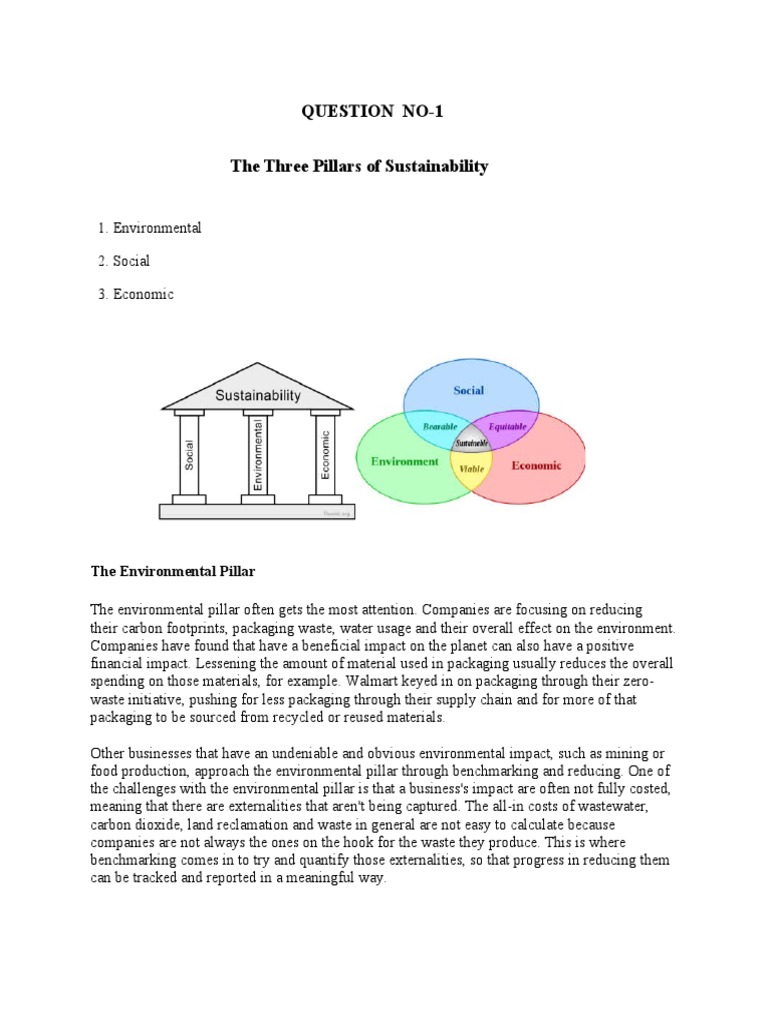Sustainability embodies a multifaceted paradigm incorporating environmental stewardship, social equity, and economic viability, commonly referred to as the three pillars of sustainability: environmental, social, and economic. Each pillar contributes uniquely to the overarching goal of sustainable development. However, the interplay between these pillars is fraught with complexities that challenge their harmonious integration. What happens when the aspirations of one pillar undermine the principles of another? This inquiry sets the stage for an exploration of the dilemmas inherent in each pillar, cradled within the context of the holistic sustainability framework.
Imagine a community aspiring to establish a powerful industrial hub to bolster economic growth. At first glance, this endeavor seems laudable; by generating jobs and economic opportunities, the community aims to uplift its residents. However, what happens to the surrounding environment when factories pollute local waterways? Herein lies the conundrum of economic aspirations clashing with environmental imperatives.
The environmental pillar aims to conserve natural resources and maintain ecosystems for future generations. Yet, projects that elevate economic performance often incur significant environmental costs. Industrial activities frequently lead to habitat destruction, diminished biodiversity, and increased greenhouse gas emissions. These detrimental impacts exacerbate climate change, posing an existential threat to future generations. The challenge arises: how can we propel economic growth without compromising the ecological integrity upon which our survival depends?
Transitioning to the social pillar elucidates further complications. Social sustainability underscores the necessity of equitable resource distribution, community engagement, and social justice. However, the capitalist drive for growth can engender inequitable practices, where marginalized communities bear the brunt of environmental degradation. For instance, the establishment of waste incineration facilities tends to occur in lower-income neighborhoods, where residents often lack the political clout to resist such developments. The juxtaposition of profit maximization against social equity reveals a profound ethical dilemma. How can we advocate for industrial expansion that does not alienate vulnerable populations?
The economic pillar presents its own set of challenges. Economic sustainability emphasizes not just the efficiency of resource use, but also the viability of economic systems in the long term. The paradox arises when short-term profit motives overshadow the imperatives for sustainable resource management. Businesses may prioritize immediate financial returns to satisfy shareholders, thereby neglecting investments in sustainable practices. Furthermore, this “pull tomorrow’s profits into today” mentality can lead to a classic tragedy of the commons phenomenon, where shared resources are overexploited to the detriment of all. How then can businesses cultivate a long-term vision that incorporates both profit and responsible stewardship of resources?
Moreover, the interdependence of the three pillars introduces additional layers of complexity. A policy aimed exclusively at fostering economic growth without ecological considerations may ignite a downward spiral. The decline of ecosystems can incite social unrest, as communities grapple with the fallout of environmental neglect. In such circumstances, social sustainability becomes a casualty, further exacerbating inequalities and tensions. The critical question looms: how can we create synergies among the pillars, ensuring their coalescence rather than conflict?
Diving deeper into social sustainability, one must consider the impediments to equitable community participation in decision-making processes. Many initiatives fail due to the lack of inclusive governance frameworks. The term “top-down” often characterizes how policies are orchestrated, with little input from the communities affected. This paradigm begs the question of legitimacy and representation—whose voices matter in the sustainability discourse? Advocating for participatory governance mechanisms is pivotal; yet, implementation remains an uphill battle.
Economically, the push towards globalization can exacerbate disparities between affluent and impoverished nations. Wealthier countries often capitalize on cheaper labor and resources found in developing nations, perpetuating a cycle of exploitation. This inequitable economic model not only undermines the social fabric of affected communities but also triggers environmental catastrophes, as these nations grapple with the toxic byproducts of industries that prioritize capital over the well-being of their people. What measures can be instituted to mitigate the adverse impacts of globalization on both social and environmental fronts?
The discourse surrounding the pillars of sustainability invariably leads to the question of accountability. Who bears responsibility when the pillars collide, and whose interests are prioritized? These inquiries stimulate further contemplation of the ethical dimensions intrinsic to sustainability. The rise of corporate social responsibility initiatives indicates a burgeoning acknowledgment of these dilemmas; yet, the extent to which these initiatives yield tangible change remains contentious. Can corporations genuinely pivot towards a sustainable ethos, or are these steps mere lip service masquerading as ethical business practices?
Lastly, the challenge of measuring progress across the pillars of sustainability must not be overlooked. Traditional metrics often fall short, focusing primarily on economic indicators such as GDP growth. However, these do not account for environmental degradation or social inequities. The development of comprehensive, multidimensional indicators that capture the intricacies of sustainability is paramount. Can innovative analytical frameworks elucidate a more profound understanding of sustainability’s complexities?
In conclusion, the intricacies of the pillars of sustainability illuminate a labyrinth of challenges. The opportunity exists to rethink our approaches, advocating for integrative practices that honor the interconnectedness of the environment, economy, and social equity. By forging a path toward cooperative frameworks that respect the inherent value of each pillar, society may strive to build a resilient future—one that considers the needs of today while safeguarding the rights of generations yet to come.










